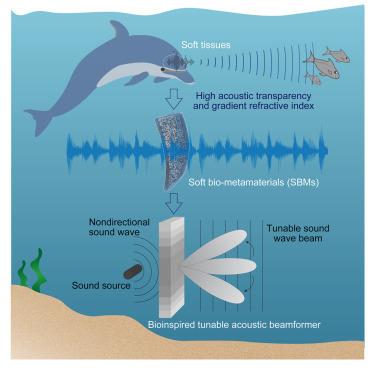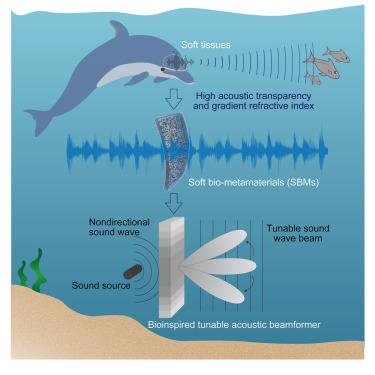用于可调声波束成形器的具有高声透明性和梯度折射率的软生物超材料
IF 17.3
1区 材料科学
Q1 MATERIALS SCIENCE, MULTIDISCIPLINARY
引用次数: 0
摘要
海豚利用额头软组织有效传输和操纵宽带声波,进行动态探测。为声学功能材料赋予高声学透明度、梯度折射率和柔软性,可以显著提高声波操纵能力。传统的超材料由固态和阻抗不匹配的元原子组成,在实现声学透明度和柔软性方面存在局限性。在这里,我们利用由分散在超弹性体中的固体微颗粒或液体微滴组成的新型声学软生物超材料(SBM)克服了这些限制。这种 SBM 具有非凡的组合特性:透射系数接近 1 的高声学透明度、高于 1.25 的梯度折射率以及与生物组织相当的低于 100 kPa 的低弹性模量。此外,我们还利用 SBM 开发了一种受海豚启发的可调亚波长声波波束成形器,它可以通过机械拉伸动态调节声波波束模式。SBM 为声学软超材料提供了一种新的设计范例,在水下监测和生物医学超声领域具有潜在的应用前景。本文章由计算机程序翻译,如有差异,请以英文原文为准。


Soft bio-metamaterials with high acoustic transparency and gradient refractive index for tunable acoustic beamformer
Dolphins utilize soft forehead tissues for dynamic detection by efficiently transmitting and manipulating broadband acoustic waves. Imparting high acoustic transparency, gradient refractive index, and softness to acoustic functional materials can significantly enhance sound wave manipulation. Conventional metamaterials, consisting of solid and impedance-mismatched meta-atoms, have limitations in achieving acoustic transparency and flexibility. Here, we overcome these constraints with a new class of acoustic soft bio-metamaterials (SBMs) composed of solid microparticles or liquid microdroplets dispersed in a hyper-elastomer. The SBMs exhibit an extraordinary combination of high acoustic transparency with transmission coefficients near 1, a gradient refractive index above 1.25, and a low elastic modulus under 100 kPa comparable to biological tissues. Furthermore, we developed a dolphin-inspired tunable subwavelength acoustic beamformer using SBMs, which can dynamically modulate acoustic beam patterns through mechanical stretching. SBMs offer a new design paradigm for acoustic soft metamaterials and have potential applications in underwater monitoring and biomedical ultrasound.
求助全文
通过发布文献求助,成功后即可免费获取论文全文。
去求助
来源期刊

Matter
MATERIALS SCIENCE, MULTIDISCIPLINARY-
CiteScore
26.30
自引率
2.60%
发文量
367
期刊介绍:
Matter, a monthly journal affiliated with Cell, spans the broad field of materials science from nano to macro levels,covering fundamentals to applications. Embracing groundbreaking technologies,it includes full-length research articles,reviews, perspectives,previews, opinions, personnel stories, and general editorial content.
Matter aims to be the primary resource for researchers in academia and industry, inspiring the next generation of materials scientists.
 求助内容:
求助内容: 应助结果提醒方式:
应助结果提醒方式:


